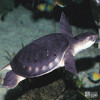Carettochelys insculpta
The Fly River Turtle is a fairly large turtle, with adults being about 18 inches in carapace length and up to 35 pounds in weight. The dorsal surfaces are gray, while the undersurfaces are whitish, and the jaws are cream-colored. There is a prominent white blotch behind each eye. There are several rectangular white areas along each side of the carapace near the margin. The snout terminates in a blunt, thickened 'breathing tube' covered with tender, wrinkled skin. The dorsal surface of the tail is covered with a single line of crescent-shaped scales, 14 to 16 in number, which decrease in size from the base to the tip. Prominent folds of skin extend laterally on each side from the undersurface of the tail across the thigh region and down the hind limbs. The limbs are paddle-shaped, two-clawed, and, while not as long or as stiff as the flippers of sea turtles, are better adapted for a life in the water than those of other freshwater turtles. The head can be pulled back inside the shell, but the neck is so thick that it was assumed originally that the head could not be retracted. The carapace is deep and globular, with a median keel near the rear. There are no scutes, the shell being covered instead with a layer of continuous skin. Carettochelys have very strong jaws. The lower jaw is somewhat scoop-shaped in front and has a ridged, expanded surface toward the rear on each side.

